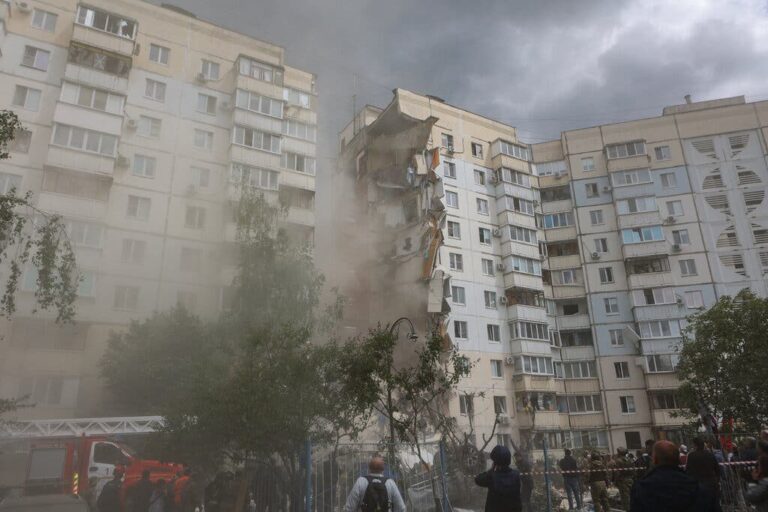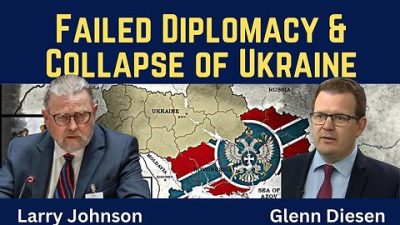Ukraine: Russia won’t escalate, US will

The aftermath of a Ukrainian attack on Belgorod, Russia, in May
BY M. K. BHADRAKUMAR | INDIAN PUNCHLINE | MAY 31, 2024
The United States’ proxy war with Russia is at another inflection point. The battleground is shifting dramatically to Russian territory — something without precedent even in the Cold War. How this pans out will be a momentous event in 21st century politics.
There are three defining issues here. One, the NATO strategy going forward, given the realisation in the West that there is no question of Russia being defeated in Ukraine; two, the constitutional crisis in Kiev with the presidential term of Vladimir Zelensky having run out on May 21; and, three, germane to all this, Russia’s intentions.
To be sure, the NATO and the EU are revamping their strategy while Russia hopes to remain “one foot ahead” of the West, as President Vladimir Putin put it.
Russia is not interested in an escalation as it is doing well in the war of attrition with Ukraine. Russia has effectively countered the US’ Mission Creep so far to push through all of its self-imposed limitations on aid to Ukraine and eventually breach those limits.
The big question today is how one could take the Biden Administration’s affirmation — stated by the White House National Security Council, the state department and the Pentagon — that it disfavours the use of western weaponry by Kiev to attack pre-war Russian territory.
An established pattern has set in whereby when Washington says some advanced weapon system is off limits for Ukraine, it actually turns out that Kiev just has to sit out for a few months so that Biden can cross the self-imposed red line.
Therefore, Russia will not take this as Washington’s final word. Curiously, the ground is being prepared to jettison the taboo, with both congressional Republicans and Secretary of State Blinken urging the White House to give the green light and both New York Times and Washington Post reporting that it is only a matter of time before the administration yields to formal American blessing to accelerate strikes on prewar Russia. (here and here)
The New York Times and Guardian reported on Thursday, in fact, a shift already in the US position that now allows Ukrainian US-supplied artillery to fire back at Russian batteries over the Russian border from Kharkov region and also to target concentrations of Russian forces massing on the border in Russia’s Belgorod region.
Meanwhile, a new phase is about to begin to conclude the Battle of Donbass, which, even after two years remains unfinished business. The entrenched Ukrainian military hubs in the region — Pokrovsk, Kramatorsk and Slovyansk — still threaten southern Donetsk Oblast.
Similarly, Volchansk on the Russian border facing Belgorod city and Kupyansk, also an important logistical point and railway node (almost 20 rail lines intersect in the town with about half track straight into Russia) are a thorn in the flesh for Russia’s border region.
Russians have openly stated that repeated raids into Belgorod city and its environs from the Kharkov Region needed to be countered with the creation of a “security zone”. Putin himself had spoken about this as early as in March.
From present indications, Russian operations are directed on two Ukrainian towns close to the border — Volchansk and Lypsti. Russia may stretch the front with a foray into Sumy oblast but any serious effort to capture either Sumy or Kharkov seems unlikely at this stage.
In an incisive analysis, the well-known Russia watcher Big Serge wrote last week, “The main purpose of these fronts will be to fix Ukrainian reserves in place and denude Ukraine’s ability to react on other fronts. This war will not be won or lost in Kharkov, but in the Donbas, which remains the decisive theatre.
“We currently appear to be solidly in the preparatory/shaping phase of a Russian summer offensive in the Donbas, which (likely among other things) will feature a Russian drive on the city of Konstyantinivka. This is the last major urban area shielding the advance towards Kramatorsk-Slovyansk from the south (remembering that these twin cities form the ultimate objective of Russia’s campaign in the Donbas.)”

Expected Russian summer offensive
Putin has strongly reacted to the recent proxy attacks on Russia’s strategic assets with western weaponry inside its territory. Putin warned that “this unending escalation can lead to serious consequences.”
As he put it, “long-range precision weapons cannot be used without space-based reconnaissance… the final target selection and what is known as launch mission can only be made by highly skilled specialists who rely on this reconnaissance data, technical reconnaissance data.
“For some attack systems, such as Storm Shadow, these launch missions can be put in automatically, without the need to use Ukrainian military… Launching other systems, such as ATACMS, for example, also relies on space reconnaissance data, targets are identified and automatically communicated to the relevant crews that may not even realise what exactly they are putting in. A crew, maybe even a Ukrainian crew, then puts in the corresponding launch mission. However, the mission is put together by representatives of NATO countries, not the Ukrainian military.
“So, these officials from NATO countries, especially the ones based in Europe, particularly in small European countries, should… keep in mind that theirs are small and densely populated countries, which is a factor to reckon with before they start talking about striking deep into the Russian territory. It is a serious matter and, without a doubt, we are watching this very carefully.”
Importantly, Putin underscored, “If Europe were to face those serious consequences, what will the United States do, considering our strategic arms parity? It is hard to tell. Are they looking for a global conflict? I think they wanted to agree upon strategic arms…We will wait and see what happens next.”
However, there are growing signs that the Biden administration may have simply mothballed the idea of western long-range weaponry being used to destroy Russia’s strategic assets deep inside its territory until the NATO summit gets over in Washington (9-11 July) so as to keep the flock together.
Equally, Biden may calculate that it is expedient to drum up tensions with Russia rather than leave the foreign policy turf to Israeli Prime Minister Benjamin Netanyahu who may land in DC to address the lawmakers. The Israeli National Security Advisor Tzachi Hanegbi told Israel’s Kan public broadcaster on Wednesday, “we are expecting another seven months of fighting” in Gaza. The Republicans are already flagging Middle East as the single biggest foreign policy goof-up by Biden. This is where the real risk lies.
There is a remarkable consistency in the Russian words that the depth of its proposed buffer security zone along the western borders will entirely depend on security considerations. The deputy chairman of Russia’s security council Dmitry Medvedev had explicitly stated recently that the security zone may not only include Kiev but also extend as far as the Polish border if the West sends Kiev long-range weapons. Significantly, on Tuesday, Putin called into question the legitimacy of Zelensky remaining in power in Kiev after his presidential term ended on May 21.
The ball is in Biden’s court. But the signs are not good. Germany, which is the US’s closest European ally, is apparently switching tack and now says that Ukraine’s “defensive action is not limited to one’s own territory, but [can] also be expanded to the territory of the aggressor.”
The chancellor’s spokesman said Berlin’s previous stance that Ukraine wouldn’t use German weapons on Russian soil had been “a statement of facts” that was true at that moment but did not necessarily apply to the future. He refused to reveal Berlin’s precise agreements with Kiev on using German weapons.
No comments yet.

Leave a comment